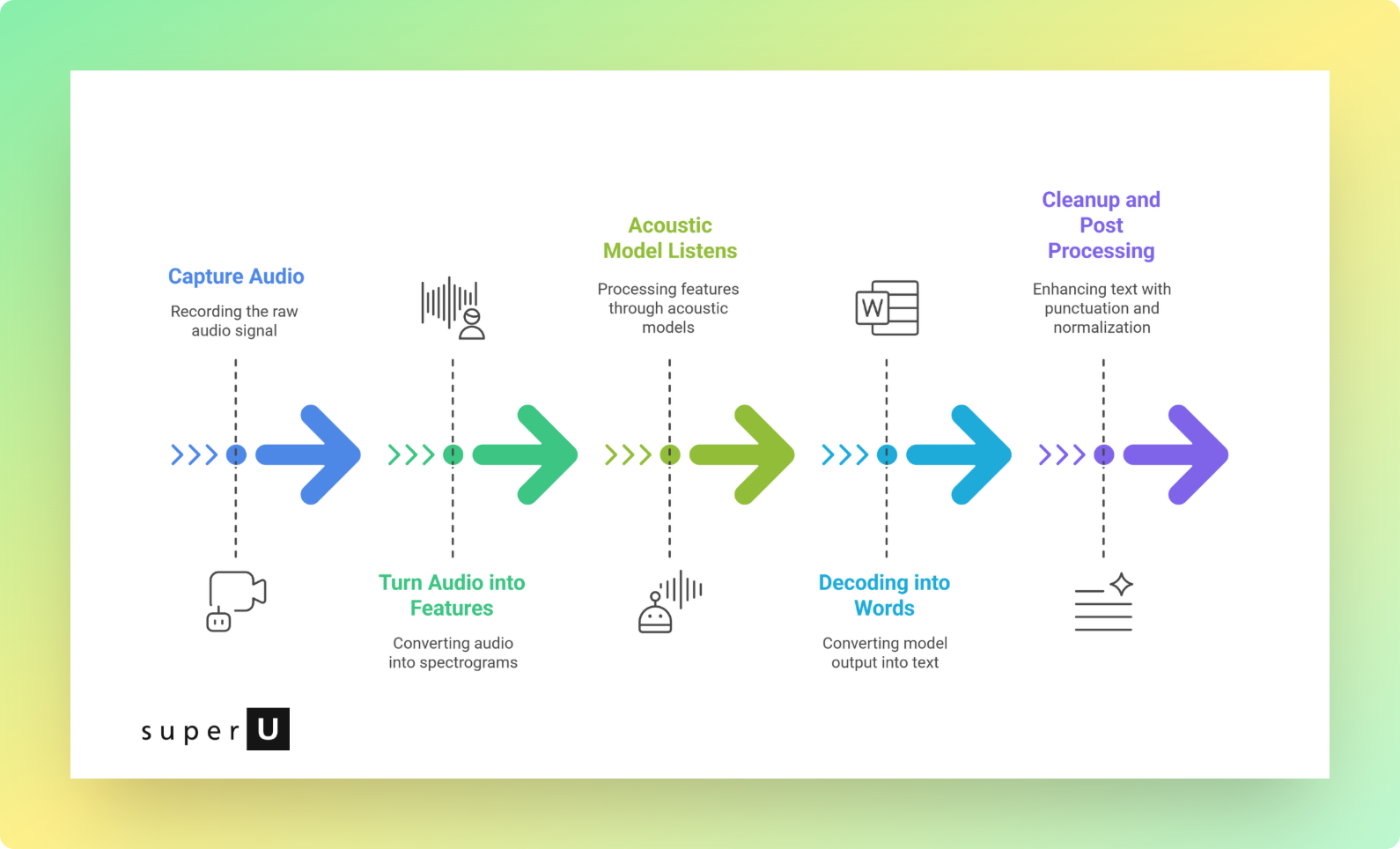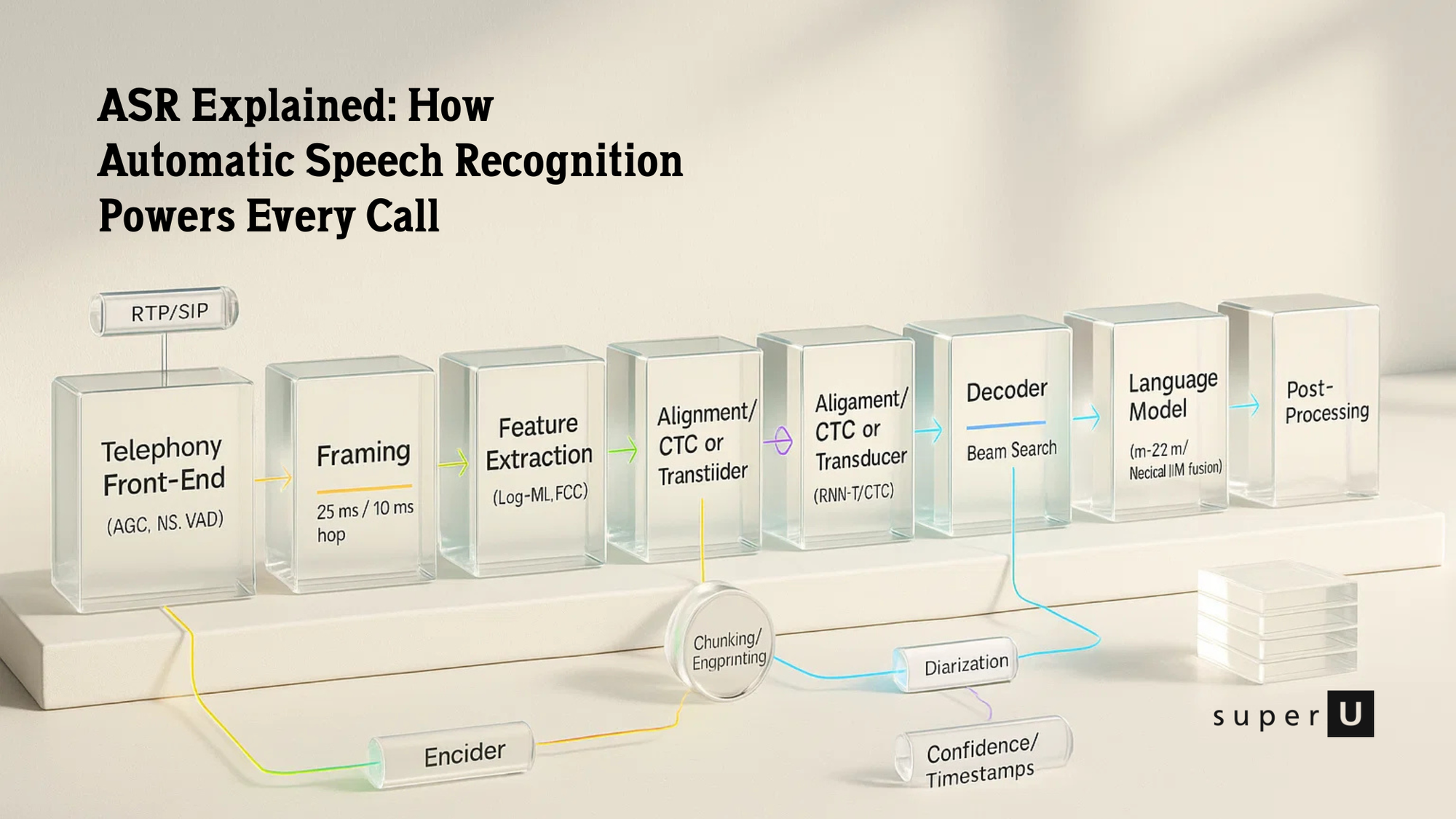TL:DR
You talk. A machine listens. Text appears.
That is automatic speech recognition, often shortened to ASR. It is the quiet engine behind live captions, phone bots, meeting notes, and more.
What is automatic speech recognition (ASR)?
At its simplest, automatic speech recognition (ASR) is technology that listens to spoken audio and converts it into written text. NVIDIA describes ASR as converting spoken language into written text so applications can use it as commands or content.
You will also see a few related terms:
- Speech to text (STT) Same idea as ASR. Many providers treat these as the same thing.
- Voice recognition Often used when the goal is to recognize who is speaking, not just what they said.
In everyday life, ASR powers:
- The captions you see on YouTube or in live events
- Voice typing on your phone
- Virtual assistants on your mobile or smart speaker
- Phone menus that ask you “How can I help you today?” and actually understand
Behind all of this is one core job: turn your voice into reliable text.
Why does automatic speech recognition matter so much now?
A decade ago, speech recognition felt slow and error prone. Today it shows up everywhere because deep learning pushed accuracy and speed to a much higher level. NVIDIA and others show how modern neural networks can handle accents, noisy backgrounds, and different languages much better than older methods.
Why it matters for you:
- Accessibility Real time captions help people who are deaf or hard of hearing, and also help everyone in noisy environments.
- Productivity Doctors dictate notes instead of typing, sales teams search call transcripts, product teams search meeting recordings.
- Better customer experience Contact centers use ASR to understand every call, coach agents, and automate simple conversations.
ASR turns messy voice interactions into structured data. Once you have text, you can search it, analyze it, and act on it.
How does automatic speech recognition work?
Let us keep this simple and walk through the typical pipeline.

1. Capture the audio
First, the system records the raw audio signal. This is the waveform you would see if you opened the file in an audio editor. Sample rate, microphone quality, and background noise all affect final accuracy.
2. Turn audio into features
Models do not work well on raw waveforms. So the system converts the signal into features like spectrograms or mel spectrograms. These are like images that show how energy in different frequencies changes over time.
You can think of it as: instead of giving the model a raw sound, you give it a visual map of the sound.
3. The acoustic or end to end model listens
This is the heart of ASR. NVIDIA and others describe two main approaches.
- Traditional “hybrid” systems
- Use an acoustic model to map audio features to phonemes (sound units)
- Use a pronunciation or lexicon model to map phonemes to words
- Use a language model to pick the most likely word sequence
- Use an acoustic model to map audio features to phonemes (sound units)
- End to end models
- Use a single deep neural network that maps features directly to characters or words
- Use architectures like CTC, RNN Transducer, or encoder–decoder models
- Use a single deep neural network that maps features directly to characters or words
Modern systems mostly rely on end to end neural architectures because they simplify training, reuse large amounts of data, and often reach better accuracy on real world audio.
4. Decoding into words
The model outputs a sequence of probabilities for characters or subword units. A decoder searches for the most likely text, often combining:
- The acoustic scores from the model
- A separate or internal language model that knows which word sequences are natural
This is where “ice cream” wins over “I scream” when context suggests you are talking about food.
5. Cleanup and post processing
Raw transcripts are usually all lowercase and without punctuation. Providers then run extra models for:
- Punctuation (., ?!)
- Capitalization
- Normalizing things like dates, currencies, and numbers
- Speaker labels (who spoke which part)
On top of this, you can add summarization, sentiment analysis, topic detection, and more. That is where ASR turns into full speech intelligence.
The key building blocks of an ASR system
Let us zoom in on the main components again, but with a little more detail.
Audio features
Audio features are compact representations that highlight patterns in the sound. Common choices include:
- Spectrograms
- Mel spectrograms
- MFCCs (Mel frequency cepstral coefficients)
These features try to capture how human hearing works, so the model learns from signals that match how we perceive sound.
Acoustic or end to end model
Deep learning has reshaped this part. NVIDIA lists architectures like QuartzNet, Citrinet and Conformer that stack convolutional and attention based layers to model long audio sequences.
End to end models often train on thousands or millions of hours of speech, covering many accents, noise conditions, and languages.
Language model and decoder
A language model estimates the probability of word sequences. AssemblyAI and others explain that combining acoustic and language models during decoding helps reduce silly errors and makes transcripts more readable.
For example, if the acoustic model is unsure between “their” and “there”, the language model decides based on context.
Extra NLP layers
Modern ASR stacks rarely stop at text. Platforms add more models on top to:
- Detect speakers (diarization)
- Summarize conversations
- Tag topics and entities
- Estimate sentiment or detect frustration
This is exactly what makes ASR so useful in contact centers and analytics tools.
How do we measure ASR accuracy?
When people say “our ASR is 95 percent accurate”, what do they mean?
Word Error Rate (WER)
The main industry metric is Word Error Rate (WER). AssemblyAI and multiple research papers define it as:
WER = (Substitutions + Deletions + Insertions) / Number of words in the reference text
- Substitution: model writes “cat” instead of “cap”
- Deletion: model misses a word
- Insertion: model adds an extra word
If a human transcript has 100 words and the ASR output has 8 errors total, WER is 8 percent.
Why WER is helpful but not perfect
WER is a solid baseline, but it does not tell the full story. Researchers point out that:
- A small error on a key number or name can hurt more than several small word mistakes
- Noisy audio, overlapping speakers, and domain specific jargon can change WER a lot
- Providers now track extra metrics like proper noun error rate or unpunctuated WER
For real products, you must test on audio that matches your actual use case, not just clean benchmark datasets.
Where is automatic speech recognition used today?
ASR has moved from labs into real products across many industries.
Contact centers and telephony
In contact centers, ASR acts as the ears of the system. Vendors and analysts highlight use cases like:
- Transcribing calls in real time
- Powering voice IVR so customers can speak instead of pressing keys
- Generating automatic summaries and tagging reasons for contact
- Detecting compliance risks or customer frustration
- Training and coaching human agents
This is exactly the space where superU operates, using ASR as the base layer for AI voice agents.
Video, media, and live events
Media companies use ASR to:
- Create transcripts of podcasts and shows
- Add closed captions to recorded and live video
- Make government meetings more accessible and searchable
- Turn long recordings into searchable archives
Custom vocabularies help handle local names and technical terms that generic ASR might miss.
Productivity and knowledge work
Teams rely on ASR powered tools for:
- Meeting transcription and action item extraction
- Voice typing and dictation in documents and email
- Searching across many hours of user research or interviews
Instead of listening again, you scan or search the text.
Healthcare and other specialized domains
In healthcare, ASR helps doctors dictate clinical notes, saving time and reducing manual data entry. In automotive, in car assistants use speech recognition so drivers can keep hands on the wheel while controlling navigation, music, or calls.
These are all examples of one pattern: turn voice into structured text, then use the text to drive workflows and decisions.
What are the main challenges in ASR?
Even with strong deep learning models, ASR still faces real world issues.
Noisy, messy audio
People talk over each other. There is traffic, fans, music, or street noise. Accuracy drops when audio quality is poor or multiple speakers overlap.
Accents, languages, and code switching
ASR needs diverse training data to handle accents and dialects. Users may also switch between languages in the same sentence, which is common in many countries.
Domain specific vocabulary
Every industry has its own jargon, product names, and abbreviations. Out of the box models often struggle with these. Many providers now support custom vocabularies and adaptation for better performance in narrow domains.
Latency and scale
For live calls or captions, latency must be very low. Systems must process audio in real time and still be accurate, even when thousands of users speak at once. NVIDIA and others focus heavily on efficient models and GPU deployment to meet these constraints.
Privacy and compliance
Audio often contains sensitive information. Good ASR deployments need strong encryption, data handling policies, and sometimes on premise or region locked processing to match regulations.
These challenges are exactly where product design and infrastructure choices matter, not just the base model.

Conclusion
Automatic speech recognition has quietly become one of the most important building blocks in modern software. It turns unstructured voice into structured text that you can search, analyze, and automate. When you plug ASR into real workflows like support or sales calls, you unlock better customer experience and sharper business decisions.
Let superU turn your customer calls into accurate, searchable, revenue ready data.


